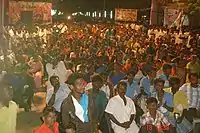Arunthathiyar
Arunthathiyar is a community from Tamil Nadu currently classified under Scheduled Caste category.[1] The community mainly speaks Tamil, Telugu and Kannada and were formerly landowners and leather-factory owners in ancient times. The term has two distinct usages: for the purposes of reservation in Tamil Nadu, in 2009 it was designated an umbrella term for the Arunthatiyar, Chakkiliyar, Madari, Madiga, Pagadai, Thoti and Adi Tamil Nadu and Andhra communities they have 3% sub-quota, while the Office of the Registrar-General, which administrates the census of India, records only the Arunthathiyar caste as Arunthathiyar.
| Arunthathiyar | |
|---|---|
 Arunthathiyar community members at an Adi Tamizhar Peravai meeting | |
| Religions | Hinduism • Christianity |
| Languages | Tamil • Telugu • Kannada |
| Populated states | Tamil Nadu • Kerala • Andhra Pradesh • Karnataka |
| Region | Northern and western Tamil Nadu |
| Population | c. 2.3 million |
The 2011 Census of India reported almost 23 lakhs community members in the country.
Origin
Arunthathiyar is cluster caste groups ,previously called as chakkiliyars and some more caste names are one of the oldest caste group and they known to be first inhabitants of southern India and tamil nadu, according to DNA research done by Indian Academy of Sciences under their research article:Genetic admixture studies on four in situ evolved, two migrant and twenty-one ethnic populations of Tamil Nadu, south India . Most scholarly authorities, including Edgar Thurston, falsely claimed that the community originated in Andhra Pradesh and migrated to Tamil Nadu in the 15th century tunder Vijayanagara Empire rule. However, the community's own history asserts that they are originally Tamil Velir kings' descendants who ruled the area around Tagadur (Dharmapuri). it is also believed that Arunthathiyars are descendants of Tamil Velir king Athiyamaan Nedumaan Anji by denoting their previous so called name Athiyakulathan/Athiyakula groups. They were taken as captives in war to Andhra and Karnataka in ancient days (Sangam period) and only returned in the 16th century as the Tamil speaking Chakkiliyars, Telugu speaking Madigas and Kannada-speaking Madari. Therefore Arunthathiyar they called themselves Adi Dravidar to represent themselves forward. They allege that these scholarly authorities, from 19th century onwards that assert Arunthathiyars migrated into Tamil Nadu are attempting to paint Arunthathiyars as outsiders and trying to call them non-Tamil. This is an Upper Caste and Colonial attempt to keep them oppressed and divided from other Dalit communities in Tamil Nadu and so prevent Annihilation of Caste.[2]
Occupation
The Arunthathiyars, although they never touched dead cattle, still worked with leather for agriculture irrigation pots and leatherworkers and cobblers, and were thus given a low social status. Many are also landless agricultural labourers and were engaged in bonded labour.[3]
Current status
The vast majority of the community, almost 18.27 lakhs, live in Tamil Nadu, with small minorities in neighbouring states. Small populations live in the Palakkad district of Kerala (40,507), and southern parts of Andhra Pradesh (30,190) and Karnataka (2,959). 62% of the community lived in rural areas, and the literacy rate is 60%.[4]
Notable people
- Madurai Veeran - King and Commander-in-chief[5]
- Ondiveeran - King and Commander of an army who fought against the British East India Company in Tamil Nadu.
- Kuyili - Queen and Friend of Velunachiyar and first suicide bomber against the Britishers in Tamil Nadu
- V. P. Duraisamy - Politician and former DMK general secretary, current vice president of Tamil Nadu BJP
- P. Dhanapal - current speaker of the Tamil Nadu Legislative Assembly
- Rao Sahib L.C. Gurusamy - member of the round table conference team led by Babasaheb Ambedkar.
References
- escNagendra Kr Singh, ed. (2006). Global Encyclopaedia of the South Indian Dalit's Ethnography. Global Vision Pub House. p. 43. ISBN 9788182201682.
- Geetha, K. A. (4 December 2014). "Unified Tamil Dalit Identity: Problematics and Anomalies". Prose Studies. doi:10.1080/01440357.2014.933575. ISSN 0144-0357.
- Salahudheen, O.P.; Salahuddin, O.P. (2010). "CHAKKLIYAS OF MANNARKKAD: A HISTORY FROM BELOW". Proceedings of the Indian History Congress. 71: 1279–1286. ISSN 2249-1937.
- S, ANANDHI (2013). "The Mathammas: Gender, Caste and the Politics of Intersectionality in Rural Tamil Nadu". Economic and Political Weekly. 48 (18): 64–71. ISSN 0012-9976.
- Vannar, Gokul (18 July 2010). "The story of Madurai Veeran". New Indian Express. Retrieved 5 April 2015.
6. Indian Academy of Sciences (aug 2011) Genetic admixture studies on four in situ evolved, two migrant and twenty-one ethnic populations of Tamil Nadu, south India